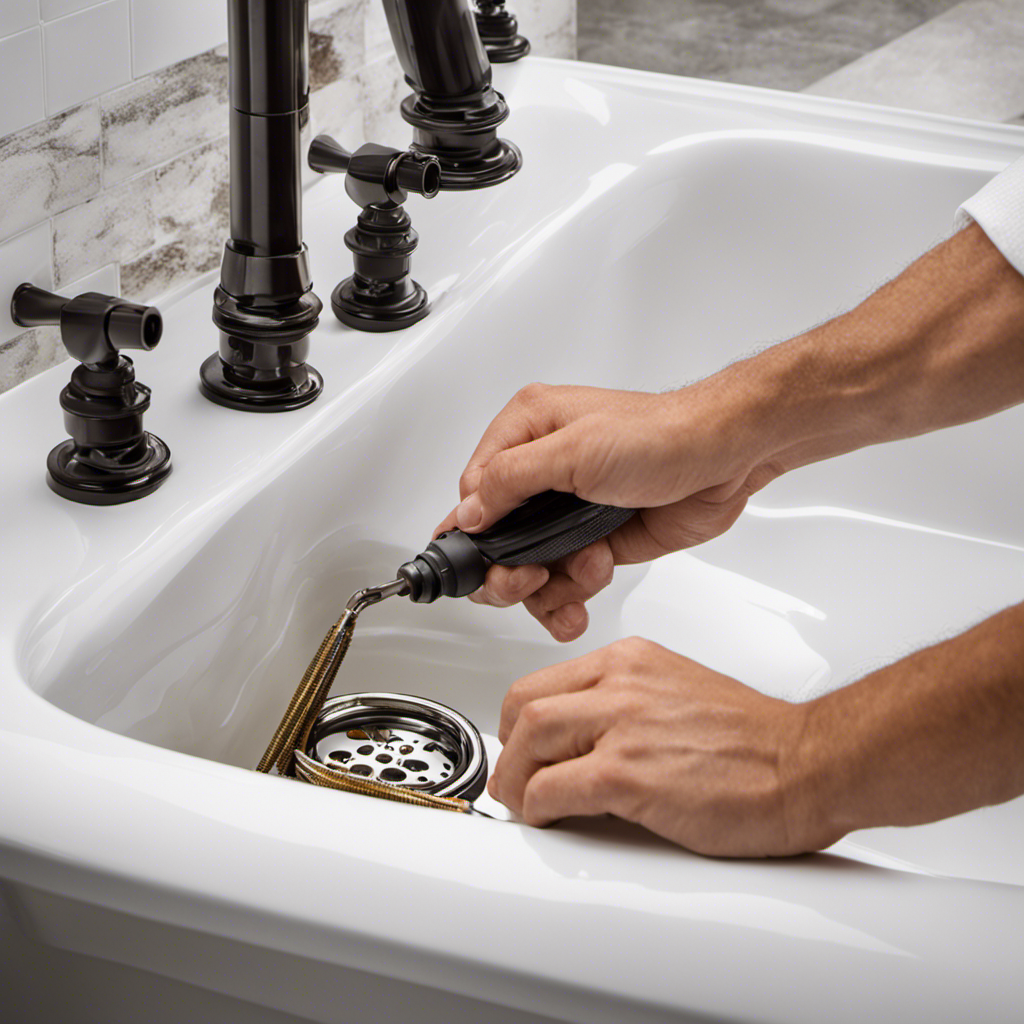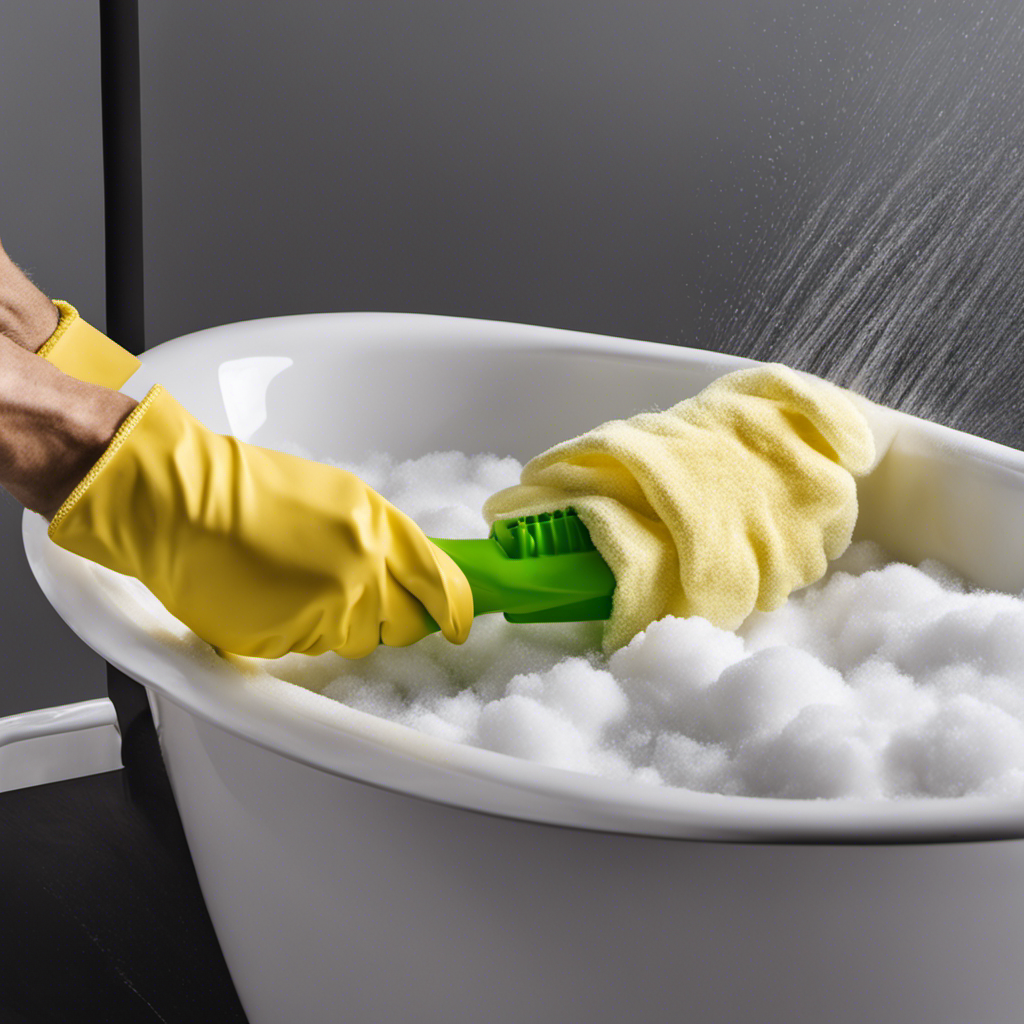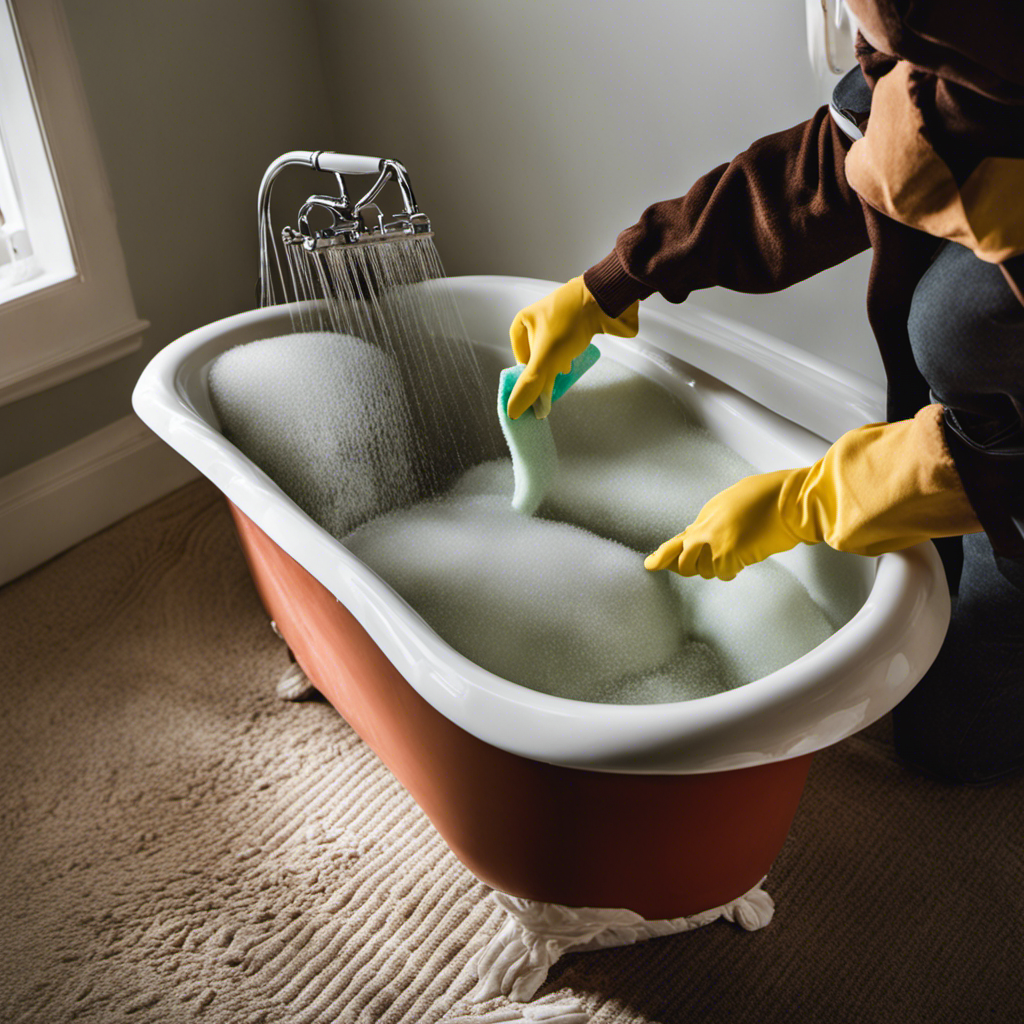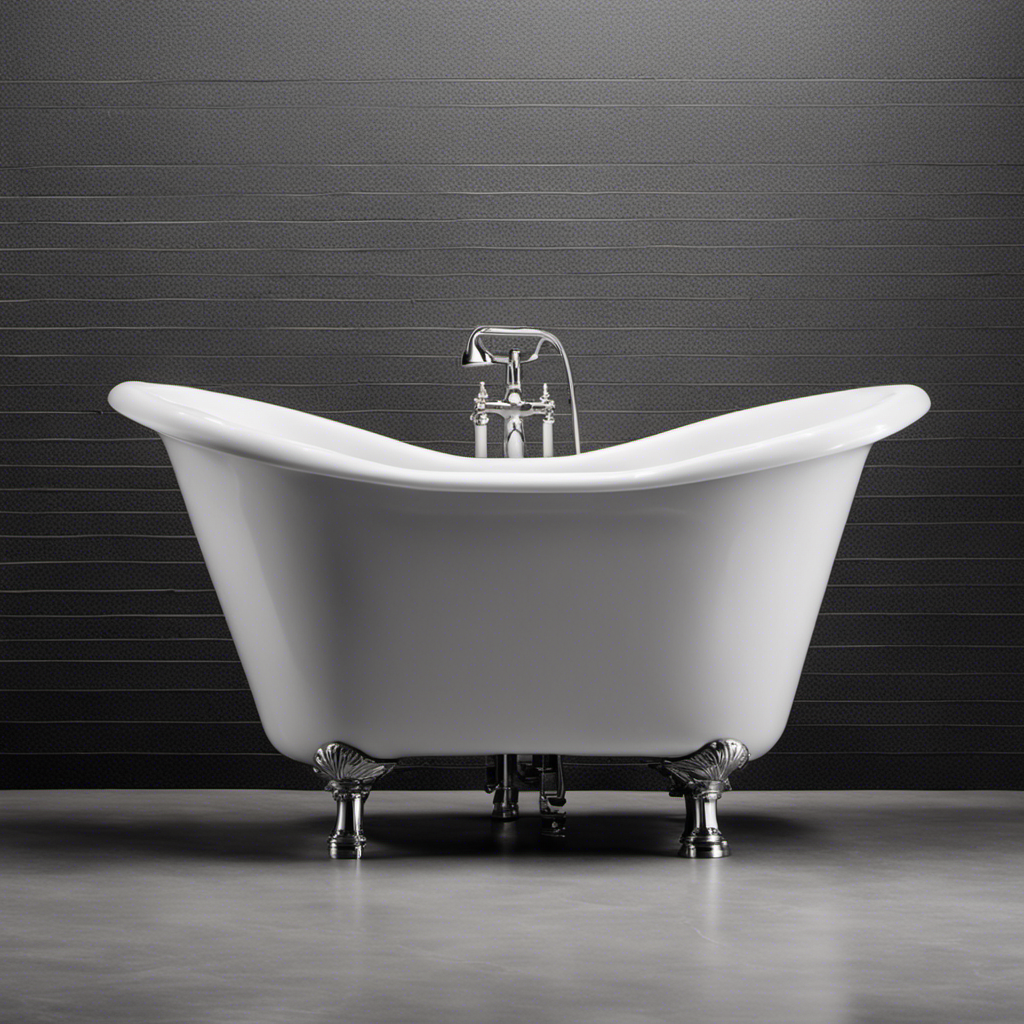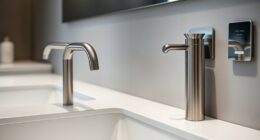As I stand in front of my bathtub, water pooling around my ankles and frustration mounting, I realize it’s time to tackle the task of fixing my clogged drain.
Luckily, with a little know-how and the right tools, this is a problem that can be solved without calling a plumber.
In this article, I will guide you through the step-by-step process of identifying the issue, removing the stopper, cleaning the drain, and ensuring your bathtub functions properly once again.
So grab your tools and let’s get started!
Key Takeaways
- Identifying the problem and gathering the necessary tools and materials are the first steps in fixing a bathtub drain.
- Different types of bathtub stoppers require different removal methods.
- Natural drain cleaning methods such as baking soda and vinegar, salt and boiling water, dish soap and hot water, boiling water, and a wire hanger can help unclog drains.
- Plungers, chemical drain cleaners, plumbing snakes, and natural remedies are all options for unclogging a bathtub drain.
Identifying the Problem
Now, you need to figure out what’s causing your bathtub drain to clog. Identifying the cause of the clog is the first step in troubleshooting methods to fix it.
Start by checking for any visible blockages in the drain, such as hair or soap scum. Use a flashlight to inspect the drain and remove any debris you can reach with your fingers or a pair of tweezers.
If the clog is not visible, try using a plunger to dislodge it. Create a tight seal around the drain with the plunger and apply firm pressure with an up-and-down motion.
If the clog persists, you may need to use a drain snake or call a professional plumber to diagnose and fix the issue.
Gathering the Necessary Tools and Materials
When it comes to fixing a bathtub drain, it is essential to have the right tools on hand. Some of the essential tools needed include a screwdriver, pliers, and a drain removal tool. These tools will help you effectively remove the drain and fix any issues that may arise.
Before starting the project, make sure to gather everything beforehand so that you have everything you need within reach. This will ensure a smoother and more efficient process, allowing you to successfully fix the bathtub drain.
Essential Tools Needed
To fix your bathtub drain, you’ll need a few essential tools.
First and foremost, you’ll need a pair of pliers. These will come in handy when removing the drain cover and loosening any screws or bolts.
Additionally, a screwdriver will be necessary for removing the overflow plate.
A drain snake is another essential tool that can help clear any clogs in the drain pipe. This flexible wire can easily navigate through the pipe and remove any blockages.
Finally, a bucket or a bowl is essential for catching any water that may spill out during the repair process.
With these required tools in hand, you’ll be ready to tackle any bathtub drain issue.
Now, let’s move on to the troubleshooting techniques to help you identify and fix the problem.
Required Materials for Success
You’ll need a few essential materials to successfully complete the repair. Here are the required materials for fixing a bathtub drain:
-
Plunger: A plunger is a must-have tool for unclogging the drain. It creates suction and helps dislodge any debris blocking the drain.
-
Drain snake: A drain snake, also known as a plumber’s snake, is used to remove stubborn clogs. It can reach deep into the drain and break up the blockage.
-
Pipe wrench: A pipe wrench is necessary for removing the drain cover and accessing the drain pipe. It provides a firm grip and allows you to twist and loosen the necessary components.
When troubleshooting a bathtub drain, these materials will come in handy. Now that you know what you need, let’s move on to gathering everything beforehand.
Gathering Everything Beforehand
Gathering all the required materials for a successful bathtub drain fix is essential. When it comes to identifying drain blockages and troubleshooting drainage problems, having the right tools and supplies on hand is crucial. To start, you will need a pair of pliers, a screwdriver, a drain snake or auger, a bucket, and some gloves. These items will help you tackle any clogs or obstructions in the drain.
Additionally, it’s a good idea to have a flashlight handy to get a better view of the problem area. Once you have gathered everything you need, you can confidently move on to the next step: removing the bathtub stopper. This will allow you to access the drain and begin the repair process.
Removing the Bathtub Stopper
When it comes to removing a bathtub stopper, it’s important to understand that there are different types of stoppers that require different removal methods. The type of stopper you have will determine how you should go about removing it.
In this discussion, I will provide detailed information on the different types of stoppers and the common methods used to remove them, so you can tackle this task with confidence and efficiency.
Different Types of Stoppers
There are various types of stoppers that can be used for bathtub drains. Each type has its own unique style and comes with its own set of pros and cons. Here are three common stopper styles and their advantages and disadvantages:
-
Push-Pull Stoppers:
- Pros: Easy to use, no complicated installation required.
- Cons: Can get stuck or break over time.
-
Trip Lever Stoppers:
- Pros: Can be easily adjusted to control water flow.
- Cons: More complex mechanism, prone to clogging.
-
Pop-Up Stoppers:
- Pros: Provides a sleek and modern look.
- Cons: Requires more maintenance, can be difficult to clean.
Understanding the different stopper styles and their pros and cons can help you choose the best option for your bathtub drain.
Now, let’s move on to the next section and learn about common stopper removal methods.
Common Stopper Removal Methods
One common method for removing bathtub stoppers is by using a screwdriver to unscrew the stopper from the drain. This method is relatively simple and can be done by most homeowners with basic tools.
To begin, locate the small screw on the stopper, usually located underneath or on the side. Use a screwdriver to turn the screw counterclockwise until it is loose.
Once the screw is loose, you can then lift the stopper out of the drain. This method is particularly useful for stopper maintenance and troubleshooting stopper issues, as it allows you to easily access the drain and inspect the stopper for any clogs or damage.
Remember to clean the stopper and drain thoroughly before reinstalling.
Cleaning the Drain
To clean the drain, you’ll need to remove the hair and debris using a drain snake or a wire coat hanger. Here are three simple DIY methods using common cleaning products:
-
Baking Soda and Vinegar: Start by pouring half a cup of baking soda down the drain, followed by one cup of vinegar. Let the mixture sit for about 30 minutes, then flush it with hot water. This combination helps to dissolve the gunk and eliminate any unpleasant odors.
-
Salt and Boiling Water: Begin by pouring half a cup of salt down the drain, then follow it with a pot of boiling water. The salt acts as a natural abrasive, helping to dislodge the debris, while the hot water flushes it away.
-
Dish Soap and Hot Water: Squirt a generous amount of dish soap down the drain, then pour hot water down to create a foaming action. Let it sit for a few minutes, then flush with hot water. The dish soap helps to break down grease and grime, leaving your drain clean and fresh.
Using a Plunger to Unclog the Drain
When it comes to unclogging a drain, using a plunger is often an effective technique. By creating a seal and applying force, the plunger can dislodge blockages and allow water to flow freely again.
However, it’s important to avoid common mistakes such as using too much force or not using the plunger correctly.
If the plunger technique doesn’t work, there are alternative methods to consider, such as using a drain snake or a homemade mixture of baking soda and vinegar to dissolve the clog.
Plunger Technique Effectiveness
You can tell if the plunger technique is effective by checking if the water level in the bathtub drain goes down. If the water level remains the same or rises, it means the plunger technique did not work.
In such cases, you may want to try some alternatives to the plunger technique. Here are three options to consider:
-
Chemical drain cleaners: These products can help dissolve clogs and clear the drain. Follow the instructions carefully and use gloves to protect your hands.
-
Plumbing snake: Also known as a drain auger, this tool can help reach deeper clogs and remove them. Insert the snake into the drain and rotate it to break up the blockage.
-
Natural remedies: Baking soda and vinegar are commonly used to unclog drains. Pour a cup of baking soda followed by a cup of vinegar into the drain. Let it sit for a while, then flush with hot water.
If none of these alternatives work, it may be time to call a professional plumber to troubleshoot the issue further.
Common Plunger Mistakes
Using too much force while plunging can actually cause more harm than good and potentially damage the pipes. It’s important to understand the correct plunger technique to avoid these common mistakes.
First, make sure you have the right plunger for the job. A cup-shaped plunger with a flat bottom is best for unclogging drains.
Next, ensure a tight seal by applying petroleum jelly to the rim of the plunger. This will create a vacuum effect and increase the plunging power.
When plunging, use short, sharp plunges rather than long, forceful ones. This will create a suction effect that can dislodge the clog.
If the plunger is not working, it’s time to troubleshoot. Check for any obstructions in the drain and remove them if possible.
If the problem persists, it may be time to try alternative drain unclogging methods.
Alternative Drain Unclogging
After realizing that plunging my bathtub drain was not working as expected, I decided to explore alternative drain unclogging methods. I wanted to find natural drain cleaning methods that would be effective without the use of harsh chemicals. Here are three options that I discovered:
-
Baking Soda and Vinegar: Start by pouring half a cup of baking soda down the drain, followed by half a cup of vinegar. Let the mixture sit for about 30 minutes, then flush it with hot water. This combination helps break down any clogs and eliminates odors.
-
Boiling Water: Boil a pot of water and carefully pour it down the drain in stages. The hot water can help dissolve grease and other substances that may be causing the clog.
-
Wire Hanger: Straighten out a wire hanger and create a small hook at one end. Insert the hooked end into the drain and try to fish out any debris or hair that may be causing the blockage.
Using a Drain Snake to Remove Debris
To remove debris from the bathtub drain, simply insert a drain snake and rotate it clockwise. This method is a practical and effective way to unclog your drain without the need for chemical drain cleaners or the expense of hiring a professional plumber. A drain snake, also known as a plumbing auger, is a flexible tool with a coiled wire attached to a handle. By inserting the snake into the drain and turning it clockwise, you can dislodge and remove any debris that is causing the clog. Here is a table that outlines the steps to using a drain snake:
| Steps |
|---|
| Insert the drain snake into the bathtub drain |
| Rotate the snake clockwise to break up the debris |
| Pull out the snake and remove any debris attached to it |
| Run water down the drain to ensure it is clear |
| Repeat the process if necessary |
Using a drain snake is a practical and cost-effective solution for clearing clogs in your bathtub drain. It allows you to take control of the situation and avoid the use of harsh chemicals or the expense of hiring a professional plumber.
Removing and Replacing the Drain Flange
When removing and replacing the drain flange, it’s important to use a wrench to loosen and remove the old flange before installing the new one. Here are the steps to successfully replace a drain flange:
-
Turn off the water supply: Before starting any plumbing work, always shut off the water supply to prevent any potential leaks or accidents.
-
Remove the drain stopper: Unscrew the drain stopper from the flange by turning it counterclockwise. Set it aside for later use.
-
Loosen and remove the old flange: Use a wrench to loosen the old flange by turning it counterclockwise. Once it’s loose, carefully lift it out of the drain.
-
Clean the drain pipe: Take the opportunity to clean any debris or gunk from the drain pipe using a wire brush or a drain cleaner.
-
Install the new flange: Apply plumber’s putty around the bottom edge of the new flange and insert it into the drain pipe. Use the wrench to tighten it clockwise until it’s securely in place.
Repairing or Replacing the Drain Pipe
If you notice any leaks or damage to the drain pipe, you should consider repairing or replacing it. Leaks in the drain pipe can cause water damage to your home and lead to costly repairs.
To repair a leak, start by identifying the source of the problem. It could be a loose connection or a crack in the pipe. If the damage is minor, you can use plumber’s tape or epoxy to seal the leak. However, if the pipe is severely damaged, it may be necessary to replace it entirely.
When replacing the drain pipe, choose a durable material like PVC or stainless steel, which can help prevent corrosion and future leaks. Remember to turn off the water supply before starting any repairs and use proper safety precautions.
Installing a New Bathtub Stopper
A new stopper can easily be installed in the bathtub to prevent water from draining out. This is a simple and effective solution to keep your bathtub filled with water for a relaxing soak.
Here are the steps to install a new bathtub stopper:
-
Remove the old stopper: Unscrew the stopper from the drain using pliers or a wrench. If it’s a push-pull stopper, lift it out of the drain.
-
Prepare the new stopper: Depending on the type of stopper you choose, follow the manufacturer’s instructions to prepare it for installation.
-
Install the new stopper: Insert the new stopper into the drain and secure it in place according to the manufacturer’s instructions. Test it by filling the bathtub with water and ensuring that it holds the water in.
Installing a new bathtub stopper is a quick and easy fix that can help you enjoy your baths without any water drainage issues.
Testing the Drain for Proper Function
To ensure proper function, check if the water holds in the tub after installing the new stopper. Testing the drain is an essential step to make sure that the installation was successful. There are several testing methods you can use to troubleshoot any issues that may arise.
One method is to fill the tub with water and let it sit for a few minutes. If the water level remains constant, then the drain is functioning properly. Another method is to use a plunger to create pressure and see if the water drains quickly. If there is slow drainage or if the water doesn’t drain at all, there may be a blockage that needs to be cleared.
Here is a helpful table summarizing the testing methods and troubleshooting tips:
| Testing Methods | Troubleshooting Tips |
|---|---|
| Fill tub with water and let it sit | Check for leaks |
| Use a plunger to create pressure | Clear any blockages |
| Observe water drainage | Adjust the stopper if necessary |
Preventing Future Drain Issues
To prevent future issues, make sure you regularly clean and maintain your stopper and surrounding area. Here are three key steps to help you prevent clogs and maintain your bathtub drain:
-
Clean the stopper regularly: Remove the stopper and clean it thoroughly, removing any hair or debris that may have accumulated. Use a brush or toothpick to dislodge any stubborn gunk. Rinse the stopper before reinserting it.
-
Use a drain cover: Invest in a drain cover to catch hair and other small objects before they go down the drain. This simple tool can prevent clogs and save you from having to deal with a backed-up drain.
-
Flush with hot water: Once a month, pour a pot of boiling water down the drain to flush away any buildup and keep the pipes clear. This simple maintenance step can go a long way in preventing clogs and keeping your bathtub drain functioning smoothly.
Frequently Asked Questions
How Do I Remove a Bathtub Drain if the Stopper Is Stuck or Broken?
To remove a stuck or broken bathtub drain stopper, start by locating the drain cover and using pliers or a screwdriver to loosen it. Then, unscrew the drain flange and remove the stopper mechanism.
Can I Use a Plunger to Unclog a Bathtub Drain if the Blockage Is Too Big?
Yes, you can use a plunger to unclog a bathtub drain if the blockage is too big. It’s a simple and effective method that doesn’t require the use of chemicals or alternative methods.
What Should I Do if I Accidentally Damage the Drain Pipe While Removing the Drain Flange?
If I accidentally damage the drain pipe while removing the drain flange, I should immediately stop and assess the extent of the damage. It’s crucial to seek professional assistance for drain pipe repair to avoid further complications.
Are There Any Specific Types of Bathtub Stoppers That Are Easier to Install?
There are various types of bathtub stoppers, each with their own pros and cons. Some popular options include push-pull stoppers, lift-and-turn stoppers, and toe-touch stoppers. It’s important to consider ease of installation when choosing a stopper.
What Are Some Long-Term Measures I Can Take to Prevent Future Drain Issues in My Bathtub?
To prevent future drain issues in my bathtub, I can practice preventative maintenance by regularly cleaning the drain using techniques such as using a plunger or a drain snake to remove any clogs or buildup.
Conclusion
In conclusion, fixing a bathtub drain can be a daunting task, but it is definitely doable with the right tools and knowledge. By following the steps outlined in this article, you can identify and address the problem, clean the drain, and even repair or replace the drain pipe if necessary.
Installing a new bathtub stopper and testing the drain for proper function will ensure that your bathtub is functioning smoothly. Remember to take preventive measures to avoid future drain issues.
With patience and determination, you can successfully fix your bathtub drain and enjoy a relaxing bath once again.
